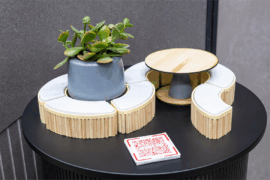Buildings are the cornerstone of modern smart cities, and in the digital economy, a new breed of buildings is emerging. What are the megatrends that drive this evolution? Laurent Bataille of Schneider Electric shares.

May 14th, 2018
Buildings are the cornerstone of modern smart cities, and in the digital economy, a new breed of buildings is emerging. Advances in mobile, cloud-based and IoT technologies are creating enormous opportunities for information gathering, sharing, and analytics impacting the way buildings are run.
In parallel, occupants demand more and more control over their workspace, driven by a “there’s an app for that” mentality. Today, this technology is evolving and can help re-invent buildings and people’s experience living in them.
Here are some key megatrends behind the changes impacting cities and buildings for the years to come.
As many as 2.5 billion people are expected to migrate to cities by 2050. At a global level, it is the equivalent of building 30 cities the size of Paris every year for the next 30 years!
This migration creates tensions for buildings developers and owners, and for city planners. Specifically, it drives the need for more:
The growth of data, information and connected devices is exponential. In 2014, there were an estimated 1.7 billion connected devices in buildings worldwide. That number will more than triple to reach 5.5 billion by 2020.
This digitisation will boost market demand for:
The world electricity consumption will increase by 60 per cent in the next 20 years, and close to 60 per cent of that electricity is used in buildings – and this is a conservative forecast!
At a time of climate change, this will drive increasing need for:
Overall, we see that these megatrends are creating a number of challenges for our cities.
A big part of the answer is to design buildings in a new way so that they utilise less resources (space, energy) and they run at maximum efficiency. Buildings must also meet the growing demand for meaningful connectivity that responds to the individual needs of occupants.
That’s what we’re doing at Schneider Electric– designing buildings differently. We are re-inventing buildings with open, innovative technology that allows for greater comfort and productivity for building occupants, enabling facility managers to deliver the next level of efficiency in buildings, and ensuring our systems integrators and EcoXpert partners win and grow through simplified commissioning and integrated systems. Visit our EcoStruxure Building website to learn more.
INDESIGN is on instagram
Follow @indesignlive
A searchable and comprehensive guide for specifying leading products and their suppliers
Keep up to date with the latest and greatest from our industry BFF's!

For a closer look behind the creative process, watch this video interview with Sebastian Nash, where he explores the making of King Living’s textile range – from fibre choices to design intent.

From the spark of an idea on the page to the launch of new pieces in a showroom is a journey every aspiring industrial and furnishing designer imagines making.

In an industry where design intent is often diluted by value management and procurement pressures, Klaro Industrial Design positions manufacturing as a creative ally – allowing commercial interior designers to deliver unique pieces aligned to the project’s original vision.

Schneider Electric’s new range are making bulky outlets a thing of the past with the new UNICA X collection.
The internet never sleeps! Here's the stuff you might have missed

From radical material reuse to office-to-school transformations, these five projects show how circular thinking is reshaping architecture, interiors and community spaces.

BLP’s new Sydney Children’s Hospital, Randwick building brings together paediatric care, family-centred design and Australia’s first Children’s Comprehensive Cancer Centre in a major addition to the Randwick Health & Innovation Precinct.